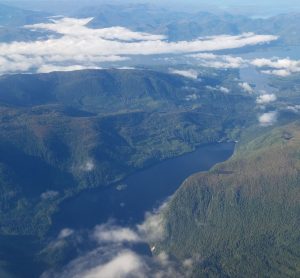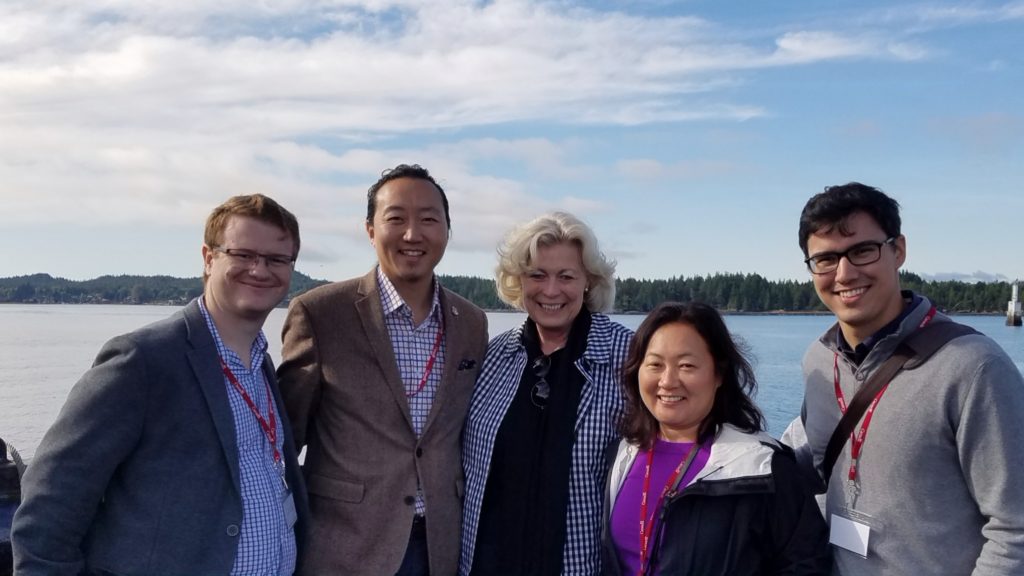Canada Border Tour – Day 2
Prince Rupert
This morning we flew to Prince Rupert, a port city on British Columbia’s northwest coast. The town is very charming with only 8,000 – 10,000 full-time residents. The flight was approximately 1 3/4 hour. Prince Rupert is near the Alaska border.
After landing at a very small airport with a prop Trans Canada airplane, we took the Digby Ferry to Prince Rupert, located on Kaien Island, which is connected to the mainland by the Yellowhead Highway.



Prince Rupert is a port city in British Columbia’s northwest coast. Prince Rupert sits 770 kilometers northwest of Vancouver. In the mid-1800s, hundreds of canneries were built along the northwest coast of British Columbia as opportunities to build wealth in the fishing industry brought European, Asian, and First Nations laborers into the area. In the early 1900s, Prince Rupert was chosen to be the final station on the Grand Trunk Railway, which runs between Winnipeg and Prince Rupert. Prince Rupert was chosen for its geography, being one of the deepest, ice-free harbors in the world, making it an ideal place to ship goods from Canada to Asia. This railway eventually became the Canadian National Railway (CN Rail), which helps to drive the region’s economy as millions of dollars of goods are shipped in and out of Canada through Prince Rupert. The town also has developed as a commercial and recreational fishing hub. Prince Rupert hosts a number of luxury cruise lines that travel between British Columbia and Alaska.
Prince Rupert Port Authority
Our first stop in Prince Rupert was lunch with the Prince Rupert Port Authority, which brands itself as the fastest-growing port for transpacific trade. We learned that it has the deepest harbor in North America, as well as the shortest Pacific route. During World War II, Prince Rupert was home to the most northerly railhead in the Americas and thus served as a port of embarkation for the war in the Pacific. Today, the vision has changed slightly, thanks to the governing body of the Port Authority, to be a “leading trade corridor ‘gateway’ between North American and Asian markets.”
The port is also ice-free and the safest port in North America, as well as the third deepest port in the world. It has the flattest rail grade to Chicago of the Western ports. Next to the health care industry, the port is the largest employer in the city. The port is geared to rail transportation and not trucking, and also not for local markets, but to borders beyond.
Don Krusel retires from helm of Port of Prince Rupert

Widely praised as a visionary leader, Prince Rupert Port Authority President and CEO Don Krusel has announced his retirement after guiding the remote port in Northern British Columbia for 25 years. He has notably transformed it into arguably the fastest-growing container port in North America, fostering both Canadian and U.S. trade with Asia.
His last major public event at the port was the ceremony on August 29 celebrating the completion of DP World’s expansion of the Fairview Container Terminal. It has boosted container-handling capacity to 1.35 million TEUs. A former breakbulk facility in a long-dormant port began to be converted in 2007.
Krusel once described the container strategy as “A Hail Mary pass for the port” and earlier this year predicted that Prince Rupert will overtake Montreal as the second-biggest Canadian container port after Vancouver within a decade. (American Journal of Transportation)
DP World Terminals
We stopped at the port where the DP World Terminals are located. DP World is a leading enabler of global trade and an integral part of the supply chain with operations in 40 countries across six continents, employing over 35,000 people. As of April 2017, DP World had a gross capacity of handling 84.6 million TEU (twenty-foot equivalent units), and the company has plans to increase that number to more than 100 million by 2020. DP World is currently expanding the Fairview Container Terminal, to be finished this year, achieving a capacity of about 1.3 million TEU. This number would be a significant increase from the 2015 throughput of over 776,000 TEUs. DP operates 24/7 all days of the year except Christmas, New Year’s Day and Labor Day.
Fairview Container Terminal
The Fairview Container Terminal in Prince Rupert became the first dedicated intermodal container terminal in North America when it began operations in 2007, converting the facilities from a general cargo port to a state-of-the-art container handing facility. It has since become a major transpacific gateway. Originally operated by a New Jersey company, DP World took over operations of the Fairview Container Terminal at the Prince Rupert Port in 2015.
Of course, every container that goes through the Fairview Container Terminal must pass through the Canada Border Services Agency (CBSA). The CBSA Container Examination Facility examines containers entering and leaving Canada. They use a variety of methods of examination, which can include an X-ray like imaging machine, a full “de-stuff” of the container, or a “tailgate exam” where the doors of the container are opened and agents have a look at the load.
The CBSA receives information not only on a container’s load, but the ship’s crew that brings it into their port, as well. About 96 hours prior to the ship’s arrival, the CBSA receives information about its crew, in order to conduct a risk assessment of all things related to the transport of the goods.
Jobs
The Port of Prince Rupert operates within the traditional territory of the Coast Tsimshian First Nations.
Benefits agreements were reached in 2011 with five Aboriginal communities — Metlakatla Band, Lax Kw’alaams First Nation, Gitxaala Nation, the Kitselas Indian Band and Kitsumkalum Band — that asserted their rights to the lands in the harbor area.
The agreement ensured that First Nations from the area participated in future growth of the business at the terminal, as well as new training and employment opportunities.
Employment opportunities for First Nation longshore women and men also has developed over the years. First Nations make up 40% to 50% of the 750 longshore positions at the terminal.
Crest Hotel
In the evening, we headed to the Crest Hotel for dinner, where we had spectacular views of the Prince Rupert Harbor, along with a wonderful seafood meal.
After dinner we promptly boarded our flight back to Vancouver to get some rest before the next day’s activities.
- Home
- Day 1:Tuesday, September 19, 2017
- Day 2:Wednesday, September 20, 2017
- Day 3:Thursday, September 21, 2017
 Blog By
Blog By
(Mrs.) Susanne Stirling
Vice President, International Affairs
susanne.stirling@calchamber.com
